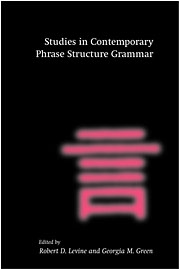Book contents
- Frontmatter
- Contents
- Introduction
- 1 The lexical integrity of Japanese causatives
- 2 A syntax and semantics for purposive adjuncts in HPSG
- 3 On lexicalist treatments of Japanese causatives
- 4 “Modal flip” and partial verb phrase fronting in German
- 5 A lexical comment on a syntactic topic
- 6 Agreement and the syntax–morphology interface in HPSG
- 7 Partial VP and split NP topicalization in German: an HPSG analysis
- Index
1 - The lexical integrity of Japanese causatives
Published online by Cambridge University Press: 16 December 2009
- Frontmatter
- Contents
- Introduction
- 1 The lexical integrity of Japanese causatives
- 2 A syntax and semantics for purposive adjuncts in HPSG
- 3 On lexicalist treatments of Japanese causatives
- 4 “Modal flip” and partial verb phrase fronting in German
- 5 A lexical comment on a syntactic topic
- 6 Agreement and the syntax–morphology interface in HPSG
- 7 Partial VP and split NP topicalization in German: an HPSG analysis
- Index
Summary
Introduction
Grammatical theory has long wrestled with the fact that causative constructions exhibit properties of both single words and complex phrases. However, as Paul Kiparsky has observed, the distribution of such properties of causatives is not arbitrary: “construal” phenomena such as honorification, anaphor and pronominal binding, and quantifier “floating” typically behave as they would if causatives were syntactically complex, embedding constructions; whereas case marking, agreement, and word order phenomena all point to the analysis of causatives as single lexical items.
Although an analysis of causatives in terms of complex syntactic structures has frequently been adopted in an attempt to simplify the mapping to semantic structure, we believe that motivating syntactic structure based on perceived semantics is questionable because in general a syntax/semantics homomorphism cannot be maintained without vitiating syntactic theory (Miller 1991). Instead, we sketch a strictly lexical theory of Japanese causatives that deals with the evidence offered for a complex phrasal analysis. Such an analysis makes the phonology, morphology, and syntax parallel, while a mismatch occurs with the semantics. The conclusions we will reach are given in (1):
(1) (a) causatives must be treated as single verbal forms with complex morphological structure. The causative morpheme should not be treated as a higher predicate as it is in most transformational/GB analyses (following Kuroda 1965), and in Gunji (this volume).
[…]
- Type
- Chapter
- Information
- Studies in Contemporary Phrase Structure Grammar , pp. 39 - 79Publisher: Cambridge University PressPrint publication year: 2000
- 5
- Cited by

